Bamboo Bandalling Technique for River Bank Protection and Flood Control – A Critical Review
1
CES, University polytechnic,
Faculty of Engineering and Technology,
Aligarh Muslim University,
Aligarh,
Uttar Pradesh
India
Corresponding author Email: mdshaheerali@zhcet.ac.in
DOI: http://dx.doi.org/10.12944/CWE.19.1.3
Copy the following to cite this article:
Ali M. S. Bamboo Bandalling Technique for River Bank Protection and Flood Control – A Critical Review. Curr World Environ 2024;19(1). DOI:http://dx.doi.org/10.12944/CWE.19.1.3
Copy the following to cite this URL:
Ali M. S. Bamboo Bandalling Technique for River Bank Protection and Flood Control – A Critical Review. Curr World Environ 2024;19(1).
Download article (pdf)
Citation Manager
Publish History
Select type of program for download
| Endnote EndNote format (Mac & Win) | |
| Reference Manager Ris format (Win only) | |
| Procite Ris format (Win only) | |
| Medlars Format | |
| RefWorks Format RefWorks format (Mac & Win) | |
| BibTex Format BibTex format (Mac & Win) |
Article Publishing History
| Received: | 2024-02-12 |
|---|---|
| Accepted: | 2024-05-13 |
| Reviewed by: | 
 Shemaa Fatih
Shemaa Fatih
|
| Second Review by: |

 Kow Ahor Essel-Yorke
Kow Ahor Essel-Yorke
|
| Final Approval by: | Dr. Marzia Ciampittiello |
Introduction
Rivers are an important resource for a country as water is the key to survival for all living beings1. India is a land of many big rivers such as the Ganges, the Yamuna, the Brahmaputra, etc. These rivers have been utilized for building multipurpose projects for irrigation, power generation, navigation, etc. Therefore, these rivers must remain functional all-round the year and provide an adequate depth. Most of these rivers are sediment-laden which decreases the effective flow day by day. Moreover, in absence of any river bank protection structure, a large amount of soil is deposited from the bank in the main stream2. River training prevents and mitigates floods. It is important due to the following reasons:
Frequent changes in the river course
Heavy shoal formation, aggradation of the river bed
Bank erosion due to floods
Changes in bed slopes due to seismic activity
River channel degradation, problems in navigation due to shoal formations
River bed degradation downstream of a dam or a barrage
Effects of spurs of different types on river behavior.3
River training works can be classified as: embankments,
Guide bunds
Spurs
Impermeable groins
Permeable groins
Bed revetment
Dredging
Porcupine systems
In the face of increasing global concerns over river bank erosion and the devastating impacts of floods, innovative and sustainable approaches to river bank protection and flood control are imperative. Among these, the bamboo bandalling technique has emerged as a promising solution, harnessing the natural properties of bamboo to mitigate erosion and manage floodwaters effectively. The bamboo bandalling technique involves the strategic placement of bamboo structures along river banks to dissipate energy, reduce erosion, and stabilize the river channel4. By capitalizing on bamboo's high tensile strength, flexibility, and biodegradability, this technique offers a cost-effective and environmentally friendly alternative to conventional engineering solutions5. Moreover, the utilization of locally sourced bamboo materials promotes community participation and strengthens social and ecological resilience in flood-prone regions 6. The schematic in Figure-1 illustrates the operational principles of bandals for regulating water and sediment movement. Sediments, comprising both bed load and suspended load, are depicted in their transportation process. In the lower half of the water flow, sediment concentration is highest, while the upper half primarily carries water discharge.
Bandals are commonly deployed to manage water depths for navigational purposes during periods of low water in alluvial rivers across the Indian subcontinent. Bamboo bandals exhibit essential features: they are positioned at an angle to the main current, with an open lower portion and a blocked upper portion.
Flow near the riverbed is redirected perpendicular to the bamboo bandal, facilitating sediment transport in that direction. Consequently, sediment accumulates on one side of the channel. The reduced flow beneath the bamboo bandals proves inadequate to transport all incoming sediment in that direction, resulting in sedimentation in that area. Conversely, the greater water flow on the opposite side carries less sediment, leading to erosion of the channel bed in that vicinity.
Through an in-depth analysis of existing literature, case studies, and field observations, this research aims to elucidate the strengths and limitations of the bamboo bandalling technique7. Additionally, it seeks to identify knowledge gaps, research priorities, and best practices for the implementation of bamboo-based river bank protection and flood control measures8. Ultimately, this critical review endeavors to inform policymakers, practitioners, and researchers engaged in sustainable river management and disaster risk reduction efforts worldwide.
Literature review
Experiments were conducted on Bandal-like Structures (fig.1) (BLS) in both clear water and live bed conditions using fine sand (d50 = 0.23mm) as sediment in a 23 m long, 2 m wide and 0.3 m deep straight channel and found that the flow depth increases by using BLS9.
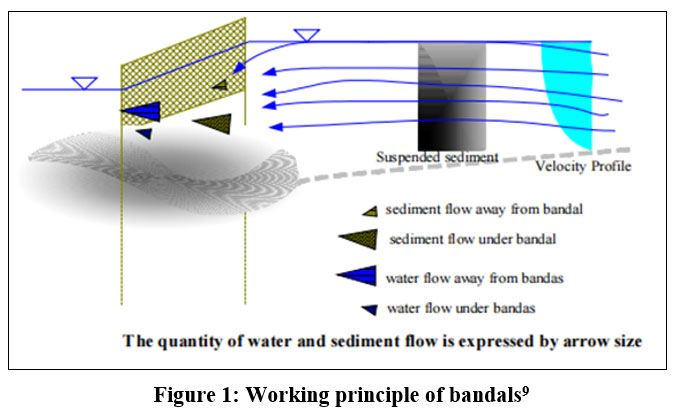 | Figure 1: Working principle of bandals9
|
The local scour depth and main channel degradation were compared for impermeable groins, simple BLS, and modified BLS (fig.2) (using an upper bended plate)10. The local scour depth in the case of bandals was found to be almost half of that of the impermeable groins. Bandals divert the water flow away from the bank, thereby preventing bank erosion (fig. 3).
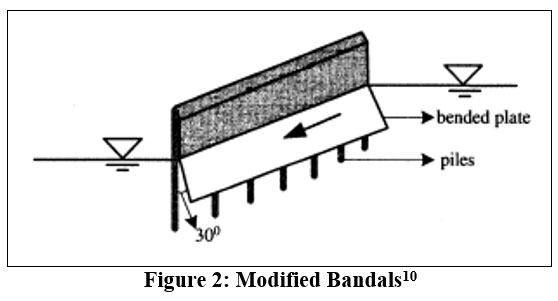 | Figure 2: Modified Bandals10
|
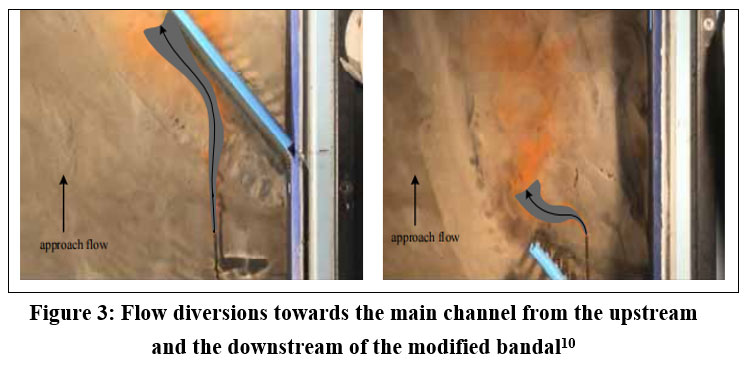 | Figure 3: Flow diversions towards the main channel from the upstream and the downstream of the modified bandal10
|
The following equations were developed for main channel degradation and local scour depth:

where Zs = degradation in the main channel below the original bed level, h = approach flow depth, u*c = critical shear velocity, u*m = depth averaged critical shear velocity, ks = roughness height at the approach section = 3d90 (where, d90 = sediment size finer than 90%); ksm = roughness height.

ds = scour depth, b= projected length of BLS measured perpendicular to the flow, 0 = angle of repose of bed sediment, E = 2/3 (1/3)n-1 for the nth BLS structure from the upstream side of the channel (taken as 2 for impermeable groins).
For the modified BLS,

where, s = flow reduction parameter due to permeable groins at the bottom part. The experimental data was found to be in near agreement with the equations developed.
The performance of modified BLS (using a 30o upper bended plate) was experimentally compared with a simple BLS both inclined at 40o towards the downstream side in a 20 m long, 1 m wide, and 0.28 m deep straight channel using fine sand (d50 = 0.19mm) as sediment and 10 pairs of BLS installed on both sides of the channel under clear water, unsubmerged condition11. It was found that there is more sedimentation around modified BLS as compared to simple BLS due to flow diversion through the upper bended plate. The maximum scour depth around BLS was predicted using a 20m long, 1.5m wide, and 0.5m deep straight concrete channel using sand (d50 = 0.3mm) as sediment and five pairs of BLS installed on both sides of the channel under clear water, unsubmerged conditions12. The developed equation for the scour depth is:

The developed equation failed to satisfy the experimental data and overestimated the scour depth by around 10-15% (for b/h < 5) and failed to predict the scour depth for b/h > 5.
The performance of BLS was tested in a straight channel 0.99m wide, and 0.3m deep with sand as sediment (d50 = 0.11mm) and 10 pairs of bandals inclined at 400 to the downstream side under a live bed, unsubmerged conditions13. Most of the suspended sediment is deposited near the channel bank (behind the bandals) and extended up to the end of the bandals. The average deposition depth near the bank was found to be 2.5 cm. The experimental data was validated using a three-dimensional computational fluid dynamics model based on Continuity equation and Navier-Stokes equation. The bamboo bandalling technique of river river training was found to be more effective as compared to dredging for preventing bank erosion14. Bandals inclined at 40o to the water flow and having fine bed materials were found to be effective for non-tidal rivers. The scour behavior was compared around different river training structures and bamboo bandalling structures were found to be the most economical amongst all others15. The three-dimensional flow around the bandals was experimentally studied in a 10m long, 0.8cm wide straight channel using powdered anthracite (d50 = 0.835mm) as sediment and a pair of bandals placed at 90o to the flow direction under live-bed, unsubmerged conditions16. The results were validated using a 3D CFD model. The performance of BLS was investigated with permeable and impermeable groins in a 0.28m deep straight channel (width = 0.8m) with powdered coal (d50 = 0.835mm) as sediment under live bed, unsubmerged conditions17. Sediment deposition in the case of BLS (around 3-4cm) was almost twice as compared to permeable groins (1-2cm) however there was erosion on the upstream side of the impermeable groins, The 3D finite volume numerical model was also in fine agreement with the experimental results. Experiments were conducted in a 22m long, 2.2m wide, and 1.5m deep straight channel placing BLS at 30o to the downward flow direction on both sides of the channel (fig. 4)18. Velocity at the banks was found to be less due to BLS as compared to the main channel, thereby causing deposition of sediment near banks.
 | Figure 4: Experimental setup of Bandals18
|
The bed variation near BLS was analysed using a straight channel with dimensions 10m by 0.8m by 0.28m under live bed, unsubmerged conditions19. The upper bended plate reduced the local scour depth around bandals. A field study was conducted in the Jamuna River by placing BLS at 300 to the downstream flow direction and concluded that there was 30m sedimentation in the horizontal direction and around 3m in the vertical direction near bandals20. The behavior of bandals and groins was studied and it was found that there was negligible erosion around BLS due to flow diversion by the upper bended plate21. However, there was erosion around impermeable groins due to the formation of the horseshoe vortex. The local scour depth around BLS was around one-fourth concerning impermeable groins. Experiments were conducted on porcupine systems (fig. 5) for riverbank protection and concluded that the maximum sediment trapping efficiency of such systems was around 82%22.
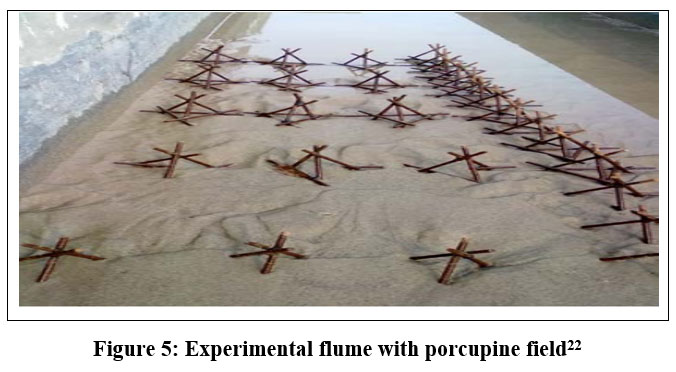 | Figure 5: Experimental flume with porcupine field22
|
Bandals were placed in the Jamuna River and it wasfound that there was huge sedimentation behind BLS and simultaneously the upstream water level matched with the downstream water level due to the placement of BLS in the river course23. A comprehensive summary of scour phenomena was provided related to spur dikes, encompassing various facets such as flow patterns, temporal and maximum scour depth, and factors influencing scour development24. The amount of sediment trapped by BLS was calculated and compared with impermeable groins25. It was found that the average sediment concentration collected at the downstream in case of BLS was 128 ppm and 133 ppm for impermeable groins. There was significant sediment deposition near the sides of the channel. The average sediment concentration also decreased on moving from the 1st BLS to the succeeding BLS (fig. 6).
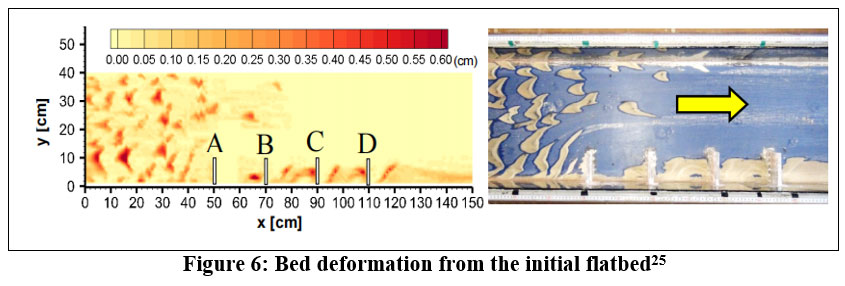 | Figure 6: Bed deformation from the initial flatbed25
|
The effect of permeable to impermeable part ratio in bandal like structure (fig. 7) on the amount of sediment deposition and found that larger the permeable to the impermeable ratio was studied26. It was found that greater is the volume of sand deposited in the channel.
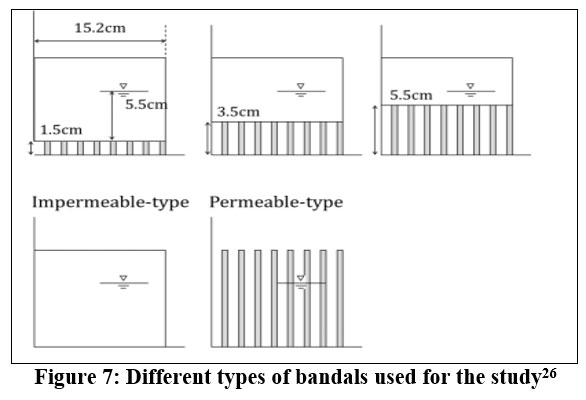 | Figure 7: Different types of bandals used for the study26
|
V-shaped bandal-like structures inclined at 45o were experimentally studied in a meandering channel using sand (d50 = 0.225mm)27. The maximum velocity was found at the center of the channel after the placement of bandals from the temporal and spatial variation of velocity. This type of bandal was found to be effective for tidal rivers as there was significant deposition of sediments near the banks due to the bandals (fig. 8).
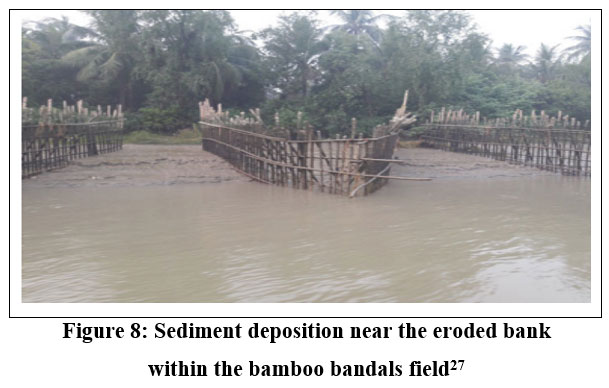 | Figure 8: Sediment deposition near the eroded bank within the bamboo bandals field27
|
Experiments were conducted to find out the maximum scour depth in a sand-gravel mixture and found that it increased with the critical velocity ratio, water depth to mean diameter of gravel particle, spur dyke length and Froude number28. The depth decreased with an increase in mean diameter of gravel particle to spur dyke length. The study proposed the following non-linear equation for estimating scour depth, with a 15% error.

where, dsa = maximum equilibrium scour depth, Frsm = Froude number of sediment mixture, da = median diameter of gravel particle, l = spur dyke length
A field study was conducted for unsteady flow analysis of BLS29. Around 5-7 m sedimentation was found near BLS during high flow. Although some of the bandals were washed away during monsoons, still there was 3-4 m sedimentation near the remaining bandals (fig. 9).
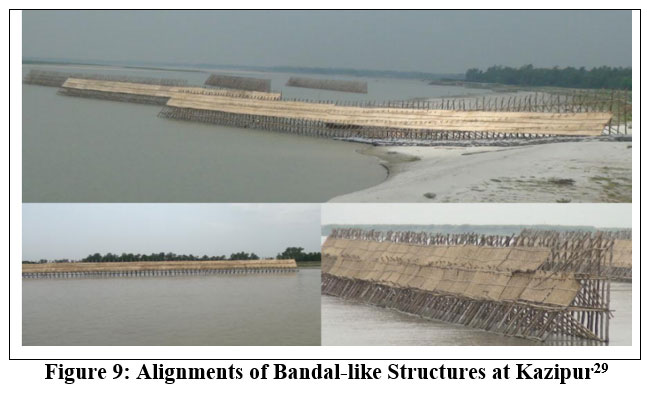 | Figure 9: Alignments of Bandal-like Structures at Kazipur29
|
The performance of a Triangular Winged Bandal-like Structure (TWBL) (fig. 10) and simple BLS were compared in a 180o bend channel under clear-water, unsubmerged conditions using sand (d50 = 0.88mm) as sediment30. It was found that the TWBL out performed simple BLS. TWBL reduces the secondary flow power by about 20% as compared to simple BLS. The relative maximum shear in TWBL is 17% concerning simple BLS. The maximum relative shear stress is increased by 56% and 30% for BLS and TWBL respectively concerning non-structured cases.
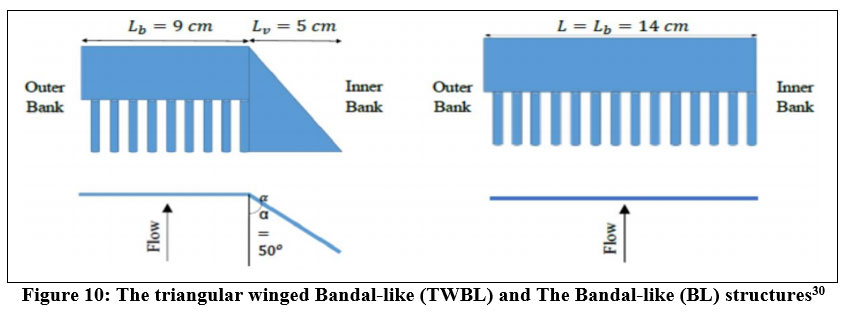 | Figure 10: The triangular winged Bandal-like (TWBL) and The Bandal-like (BL) structures30
|
A hybrid river training setup was evaluated using OpenFOAM, focusing on mitigating downstream flow velocity and redirecting flow towards the opposite bank31. The hybrid configuration outperformed traditional layouts like porcupine and geobag, reducing downstream velocity by 1.33%, 11.62%, and 13.34%, respectively. The porcupine structure in the hybrid layout reduced incoming flow force before reaching the impermeable geobag, eliminating bed scour. A comprehensive investigation was done into the maximum depth of scour proximate to a spur dike, employing a combination of FLOW-3D simulations and empirical observations32. The study revealed an initial rapid escalation in scour depth, achieving approximately 10% of its equilibrium state within a condensed time frame. Subsequent observations indicated that nearly 80% of the total scour depth was achieved within 20% of the equilibrium duration. Remarkably, the most substantial scour depth was detected at the upstream nose of the spur dike, whereas sediment deposition predominantly occurred downstream of the structure. Moreover, the depth of scour near the spur dike exhibited a positive correlation with higher bed load coefficients. Furthermore, the findings underscored the differential predictive capabilities of the Large Eddy Simulation (LES) model compared to the k-E and RNG models, with the former tending to overestimate scour depth. Nonetheless, the predictions derived from the RNG model closely aligned with experimental data, demonstrating a commendable level of concordance. Meanwhile, field assessments of hybrid river training models were done incorporating BLS and geobags in the Jamuna River, particularly focusing on high-flow velocity conditions exceeding 2 m/s, revealing their efficacy surpassing alternative river training interventions33.
Numerical simulation procedure
The effectiveness of hydraulic structures in river engineering can be studied with the help of numerical modeling. The modeling techniques used to study the behavior of bandals in rivers are Genetic Algorithm, ANN model and Computational Fluid Dynamics34.
Artificial Neural Networks (ANNs) represent computational models inspired by the structural and functional aspects of biological neural networks in the brain. These models are meticulously trained to identify intricate patterns, classify diverse datasets, and execute various tasks within the realms of machine learning and artificial intelligence (AI) applications. Conversely, Genetic algorithms (GAs) constitute heuristic search and optimization methodologies founded upon the principles of natural selection and genetic inheritance. They are adeptly employed to seek optimal solutions for intricate and multifaceted problems across diverse domains. Computational Fluid Dynamics (CFD) is a fluid mechanics branch that uses numerical methods to analyze and solve fluid flow problems, dividing the fluid domain into control volumes.
Genetic Algorithm (GA)
Multiple local minima can be used by GA to minimize the objective functions of multiple models. GA can also be used to minimize non-differentiable, discrete, and discontinuous objective functions. The following steps make up the GA's basic operating system:
The first phase of GA is the initial population (an array of randomly picked people). Each member of the initial population's relative fitness is determined by the fitness function. It depends on the convolution of the problem being reduced. Any of the following stopping conditions results in the GA coming to an end. The best point's objective function must be less than or equal to the fitness limit, for example (Fig. 11).
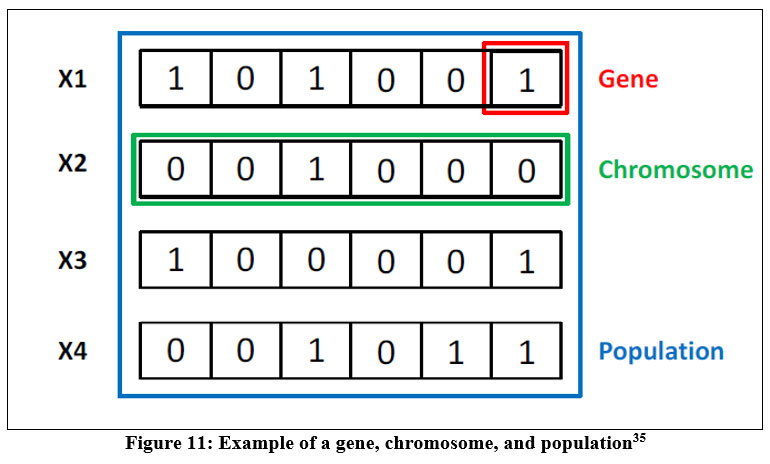 | Figure 11: Example of a gene, chromosome, and population35
|
A novel model was developed integrating genetic algorithm (GA) with finite element modeling to ascertain the optimal values for both the inclination angle and cutoff location within a hydraulic structure, under the constraint of a predefined ratio between cutoff depth and floor length36.
Artificial neural Networks (ANN)
ANN is a collection of sequentially ordered algorithms that aims to imitate how the human brain works. To establish relationships between the various parameters of a complex problem, ANNs learn from the set of available data. When an input-output dataset is available but the underlying relationship between the various parameters is unclear, ANNs are the best option37.
When the input and output datasets can be obtained experimentally but the underlying physics is too complex to establish, ANNs are also suitable for modelling complex phenomena. In these circumstances, ANNs use the available data set to learn from the relationships between the variables and provide a straightforward solution38.
Without conducting experiments, the model thus produced can be used to forecast the solution to such challenging problems. Fig. 12provides a typical illustration of an ANN model. The number of hidden layers grows along with the problem's complexity.
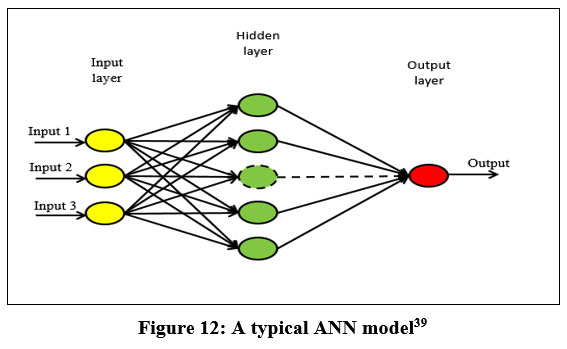 | Figure 12: A typical ANN model39
|
A neuron is an ANN model's fundamental unit. In the input layer, each neuron processes the input data. Subsequently, this processed input, after passing through the activation function and being weighted, is transmitted to the next hidden layer. Connections exist between every neuron in one layer and every neuron in the subsequent layer. Following traversal through the hidden layers, the signal ultimately reaches the output layer, constituting a feed-forward process. This output value is then compared with the actual output. The disparity between the calculated value and the actual value represents the error. To minimize this error, the signal is propagated backward from the output layer to the hidden layer through back-propagation. During this phase, adjustments are made to the weights to diminish the error. This iterative process continues until a predetermined number of iterations is reached or the desired outcome is achieved. Artificial neural network (ANN) modeling was employed utilizing a back-propagation learning technique to predict the maximum depth and length of scour holes downstream of hydraulic structures40. An ANN model was developed for forecasting the discharge coefficient of oblique sharp-crested weirs41.
Computational Fluid Dynamics (CFD)
The intricate 3D flow patterns and morphological alterations around structures such as Bandal-like formations appear to be more accurately depicted by 3D models compared to the 2D models traditionally employed by river engineers. The absence of a 3D model renders it impossible to adequately capture the finer intricacies of flow around such structures. Within the numerical model, the flow field is derived using the Reynolds-averaged Navier-Stokes (RANS) equations. At the outlet boundary, all flow variables are presumed to have zero flow. This numerical framework is constructed using the widely utilized Finite Volume Method (FVM). Past research by has documented 3D RANS simulations investigating flow dynamics amidst multiple structures with a movable beds42,43,44,45,46,47,48,49,50.
Simulation results of CFD simulations are crucial for understanding the flow behavior of various hydraulic structures, including bamboo bandal structures used for river training. However, there are several limitations and uncertainties in these models. Bamboo characteristics, such as dimensions, porosity, and flexibility, can introduce uncertainties in the simulation results. Turbulence modeling, meshing challenges, and fluid-structure interaction (FSI) also pose challenges. The choice of meshing strategy can influence the simulation results. Limited experimental data for flow around bamboo bandal structures also hinders the validation of CFD simulations.
Additionally, real-world environmental conditions, such as variations in river flow rates and sediment transport, introduce uncertainties in boundary conditions for CFD simulations. Therefore, it is essential to address these limitations and uncertainties in CFD models to improve the accuracy of simulations.
Procedure for performing CFD analysis of bamboo bandals
Model Development:
A two-dimensional computational model of the river reach where bamboo bandals are to be installed is developed.
A numerical solver capable of solving shallow water equations coupled with sediment transport equations is utilized51.
Geometry and Boundary Conditions:
The geometric properties of the river channel, including width, depth, and slope are defined.
Boundary conditions such as water inflow rates, sediment input, and downstream conditions are defined.
Material Properties
The hydraulic and sediment transport properties of the riverbed material and bamboo bandals are described.
Data is obtained on bamboo dimensions, porosity, and hydraulic roughness coefficients.
Bamboo Bandal Configuration
The geometry and placement of bamboo bandals are incorporated into the computational domain.
The angle of inclination, height, and spacing of the bandals are specified based on empirical guidelines and field observations.
Numerical Simulation Setup:
The numerical simulation is setup with appropriate time and spatial discretization schemes.
The simulation duration is defined to capture both short-term and long-term effects of bamboo bandalling.
Model Calibration and Validation:
The numerical model is calibrated using observed data from field measurements or previous studies.
The model is validated by comparing simulated results with independent field data or analytical solutions.
Simulation Execution
The numerical simulation is executed to analyze the hydraulic and sediment transport processes with bamboo bandals in place.
Key parameters such as water depth, velocity distribution, sediment concentration, and bed morphology are monitored.
Performance Evaluation:
Bamboo bandalling techniques is evaluated in terms of flow regulation, sediment deposition, and channel morphology.
Analysis of the different bandal configurations for flow patterns and sediment transport..
Sensitivity Analysis:
Sensitivity analyses is conducted to investigate the influence of input parameters and model assumptions on simulation results.
The sensitivity of bamboo bandalling effectiveness to variations in bandal geometry, flow conditions, and sediment properties is observed.
Results Interpretation and Reporting
The simulation results are analyzed to draw conclusions regarding the efficacy of bamboo bandalling for river training.
Results and discussion
The bamboo bandalling technique of river training was found to be effective for both tidal and non-tidal rivers. These structure not only prevent bank erosion but also cause sedimentation along the river banks, thereby reducing the sediment load of rivers. Bamboo being a biodegradable and non-toxic material, causes no harm to the aquatic flora and fauna. Moreover, it is easily and cheaply available, therefore the contruction cost of these structures is too low as compared to other river training works. However, these structures can last for only a single monsoon season and have to be replaced by fresh structures in the next monsoon. Thus, bamboo bandalling structures can be effectively used for river training and flood control in low discharge rivers under unsubmerged conditions.
Conclusion
A thorough examination of both experimental and numerical investigations on scour around bandalling structures has been presented. Recent researchers have elucidated the disparity in velocity distribution around bandals. Addressing the challenge of minimizing scour around bandals and enhancing sediment deposition near river banks has been a focal point for certain researchers, who have explored various remedial techniques. Despite numerous studies on the hydraulics of flow around bandals, certain aspects merit further exploration to provide satisfactory solutions for scour control downstream of bandals. These include investigating the impact of bandal inclination with flow direction, bandal efficiency at high discharge, and the characteristics of flow over a mixture of sediments with varying sizes. Additionally, the considerable influence of large-scale model distortion in the laboratory compared to the prototype underscores the necessity for extensive model studies to gain insights into the associated problems. The real-life scenarios of flow and sediment transport are characterized by unsteadiness and non-uniformity. In such conditions, structures undergo variable states, transitioning between non-submerged and submerged conditions. Exploring the efficiency of Bamboo Bandalling Structures (BLS) in these situations is crucial and should be investigated in controlled laboratory conditions in future research endeavors. Moreover, there is a need for comprehensive inquiry into the efficiency of BLS in sediment trapping in rivers, aiming to evaluate its viability as a Nature-based Solution for land reclamation along coastal areas. Further details are necessary to comprehend the practical benefits of these structures in such contexts.
Here is an overview of the strengths and weaknesses of each numerical simulation procedure:
Artificial Neural Networks (ANN)
Strengths:
Nonlinear Relationships: ANNs excel in capturing complex nonlinear relationships between input and output variables.
Adaptability: They can adapt and learn from training data, making them suitable for modeling systems with evolving behavior.
Weaknesses:
Overfitting: ANNs are prone to overfitting, especially with limited or noisy data, leading to poor generalization performance.
Data Dependency: ANNs heavily rely on the quality and quantity of training data.
Genetic Algorithm (GA)
Strengths:
Global Optimization: GAs are effective in finding global optima for complex, multi-modal optimization problems, making them suitable for nonlinear and high-dimensional search spaces.
Versatility: GAs can handle various types of objective functions and constraints, including non-differentiable, discontinuous, and noisy functions.
Weaknesses:
Convergence Speed: GAs may require many iterations to converge to the optimal solution, especially for complex problems with rugged landscapes.
Premature Convergence: GAs are susceptible to premature convergence, where the population converges to a sub-optimal solution before reaching the global optimum.
Computational Fluid Dynamics (CFD):
Strengths
High Fidelity: CFD provides high-fidelity simulations of fluid flow phenomena, capturing detailed flow features and dynamics with accurate numerical methods.
Versatility: It can model a wide range of fluid flow problems, including laminar and turbulent flows, multiphase flows, and heat transfer phenomena.
Weaknesses:
Computational Cost: CFD simulations can be computationally expensive, especially for complex geometries, turbulent flows, and transient phenomena, requiring high-performance computing resources.
Model Assumptions: Simplifications and assumptions in turbulence modeling, boundary conditions, and fluid properties may introduce uncertainties and limitations in CFD predictions.
Validation and Verification: CFD simulations need to be validated and verified against experimental data or analytical solutions to ensure their accuracy and reliability, which can be challenging and time-consuming.
Acknowledgments
I acknowledge the support of my department.
Funding Sources
The author(s) received no financial support for the research, authorship, and/or publication of this article.
Conflict of Interest
The author(s) declares no conflict of interest.
Data availability statement:
The manuscript incorporates all datasets produced or examined throughout this research study
Ethics Approval Statement
Not applicable
References
- Sustainable Development Goal 6: Ensure Availability and Sustainable Management of Water and Sanitation for All. United Nations Publications, 2015.
- Sharma, A. K., and Bhattacharya, A., River Bank Protection: Bamboo Bandalling as a Sustainable Solution. International Journal of River Basin Management, 2017;15(4):423-436.
- Kumar S., River Training Works: Principles, Practices, and Challenges. CRC Press, 2020.
- Nath, T. K., and Nath, T. K., Bamboo Bandalling: A Sustainable Approach for River Bank Protection and Flood Management. Journal of Water Resources and Hydraulic Engineering, 2022;11(3):87-99.
- Mohanty, P., and Patel, D., Innovative Approaches to River Bank Protection and Flood Control: A Case Study of Bamboo Bandalling in India. International Journal of Environmental Research and Public Health, 2019;16(10): 18-50.
- Singh, R., and Srivastava, R., Sustainable River Management: Bamboo Bandalling for Flood Control and Bank Protection. International Journal of Sustainable Development and Green Economics, 2015;4(2):78-90.
- Goyal M. R., and Ojha C. S. P., Rivers and River Basin Management. Springer, 2016.
- Mandal S., and Pal S., Bamboo Bandalling Technique for River Bank Protection and Flood Control: A Review. Journal of Sustainable Development and Environmental Protection, 202;7(1): 32-45.
- Rahman MM, Nakagawa H, Ishigaki T, Khaleduzzaman. Channel stabilization using bandalling. Annuals of Disaster Prevention Research Institute, 2003;46 (B):613–618
- Rahman, M., Nakagawa, H., Khaleduzzaman, A. T. M., Ishigaki, T., & Muto, Y.. On the Formation of Stable River Course. Annuals of Disas. Prev., 2004;47(B):1-15
- Rahman MM, Nakagawa H, Khaleduzzaman ATM Ishigaki T. Formation of navigational channels using bandal-like structures. Annual Journal of Hydraulic Engineering, JSCE, 2005;49:997-1002
CrossRef - Rahman MM, Nakagawa H, Ito N, Haque A, Islam T, Rahman MR, Hoque MM. Pridiction of local scour depth around bandal like structures. Proceedings of hydraulic engineering, 2006;50:163-168
CrossRef - Rasheduzzaman M, Nakagawa H, Zhang H, Rahman MM, Muto Y. Flow and sediment transport around bandals under live bed scour condition. Proceedings of hydraulic engineering 2007;51:145-150
CrossRef - Sharmin, R., Rahman, M. M., Matin, A., Haque, E., Hossain, I., and Razzak, A.. Effectiveness of Bandalling and dredging for the maintenance of navigation channels in the Jamuna River. International Conference on Water and Flood Management, 2007;125-133.
- Alauddin M. Flow and erosion processes at bends and around river training works in sand bed braided rivers.Ph.D. Thesis, IWFM, Bangladesh, 2010
- Zhang H, Nakagawa H, Baba Y, Kawaike K, Teraguchi H. Three-dimensional flow around bandal-like structures. Annual Journal of Hydraulic Engineering, JSCE, 2010;54:175-180.
- Teraguchi H, Nakagawa H, Kawaike K, Baba Y, Zhang H. Morphological changes induced by river training structures; Bandal like structures and groins. Annuals of Disaster Prevention Research Institute, Kyoto University, 2010;53 (B):595-605
- Rahman ML, Basak BC, Osman MS. Velocity distribution around bandalling for navigation channel development. Proceedings of the International Conference on Mechanical Engineering, 2011
- Nakagawa H, Teraguchi H, Kawaike K, Baba Y, Zhang H. Analysis of bed variation around bandal like structures. Annuals of Disaster Prevention Research Institute, Kyoto University, 2011;54(B):497-510
- Rahman ML, Basak BC, Osman MS. River bank stabilization with the application of bamboo bandalling structures- a case study. 4th Annual Paper Meet and 1st Civil Engineering Congress, 2011;399-406
- Teraguchi H, Nakagawa H, Kawaike K, Baba Y, Zhang H. Alternative methods for river training works: Bandal like structures. Journal of Hydraulic Engineering, JSCE, 2011;67:151-156
CrossRef - Aamir M, Sharma N. Sediment trap efficiency of porcupine systems for riverbank protection. ISH-HYDRO 2014 International, 2014;1-9
- Rahman ML, Osman MS. River bank erosion protection using bamboo bandalling structure: a case study. Journal of Civil Engineering (IEB), 2015;43(1):1-8
- Pandey M, Ahmad Z and Sharma PK. Scour around impermeable spur dykes - a review, ISH journal of hydraulic engineering, 2017;24(1):24-44
CrossRef - Zhang, H., Nakagawa, H., Kawaike, K., & Nishio, K. Investigation of Suspended Sediment Transport and Bed Deposition around Bandal-like Structures. 12th International Conference on Hydroscience & Engineering Hydro-Science & Engineering for Environmental Resilience, 2016;10–13
- Hasegawa, Y., Tai, S., Shampa, Kawaike, K., & Nakagawa, H.. Experimental Study on Sediment Deposition Using Bandal Like Structure with Different Ratio of Permeable and Impermeable Part. Symposium Proceedings of the INTERPRAENENT 2018 in the Pacific Rim, 2018;215–221.
- Pandey M, Lam W.H., Cui Y, Khan M.A., Singh U.K. and Ahmad Z. Scour around Spur Dike in Sand–Gravel Mixture Bed, Water, 2019;11:14-17.
CrossRef - Rahman ML. Study of bamboo bandalling structures in the tidal river for river bank erosion, Proceedings of the fourth international conference in ocean engineering, 2019:49-57.
CrossRef - Rahman MA, Rahman MM, Shampa, Haque A, Dustegir MM, Nishat NJ, Nakagawa H, Hossain M. Performance evaluation of bandal like structures for sediment management in braided jamuna river. Proceedings of the 22nd IAHR-APD Congress, 2020;1-7
- Sardasteh A, Bejestan MS, Ayyoubzadeh SA, Samani JMV. Hydrodynamic performance of triangular winged bandal like structures. J Agri. Sci. Tech, 2021;23(3):737-749
- Kakati, R., Chembolu, V. & Dutta, S. Experimental and Numerical Investigation of Hybrid River Training Works using OpenFOAM. Water Resour Management, 2022;36:2847–2863.
CrossRef - Gupta L.K., Pandey M, Raj P.A. Numerical modeling of scour and erosion processes around spur dike, Clean - Soil, Air, Water, 2023;2300135:1-11
CrossRef - Rahman, M.M., Shampa, Haque, A. et al. Sediment management using bandal-like structures as nature-based solution. Environmental Fluid Mechanics,2023. https://doi.org/10.1007/s10652-023-09945-x
CrossRef - Holland, J. H., Adaptation in Natural and Artificial Systems: An Introductory Analysis with Applications to Biology, Control, and Artificial Intelligence, MIT Press, 1992. https://doi.org/10.7551/mitpress/1090.003.001
CrossRef - Goldberg DE, Genetic algorithms in search, optimization, and machine learning. Addison-Wesley, New York, 1989.
- Hassan W.M. Application of a genetic algorithm for the optimization of a cutoff wall under hydraulic structures, Journal of Applied Water Engineering and Research, 2015;5(1):22-30
CrossRef - Ali MS, Ayaz M, Mansoor T. Prediction of discharge through a sharp-crested triangular weir using ANN model trained with Levenberg–Marquardt algorithm. Modelling Earth System Environment, 2021;8(2):1-13.10.1007/s40808-021-01167-8
CrossRef - Schalkoff RJ, Artificial neural networks. The McGraw Hill Companies, Inc, New York, 1997.
- Zurada JM, Introduction to artificial neural systems. Jaico Publishing House, Mumbai, 1990.
- Soliman M. Artificial neural network prediction of maximum scour hole downstream hydraulic structures, Eleventh International Water Technology Conference, IWTC11, 2007;769-777
- Ayaz M, Mansoor T. Discharge coefficient of oblique sharp crested weir for free and submerged flow using trained ANN model. Water Science, 2018;32(2):192–212. https://doi.org/10.1016/j.wsj.2018.10.002
CrossRef - Peng, J., Tamai, N., Kawahara, Y., and Huang, G.. Numerical modeling of local scour around spur dikes, Proceedings of 28th IAHR Congress, 1999
- Nagata, N., Hosoda, T., Nakato, T. and Muramoto, Y., Three-dimensional numerical model for flow and bed deformation around river hydraulic structures, J. Hydr. Eng., ASCE, 2005:131(12):1074-1087
CrossRef - Zhang, H., Nakagawa, H., Muto, Y., Baba, Y. and Ishigaki, T. Numerical simulation of flow and local scour around hydraulic structures, River flow 2006;1683-1693 http://dx.doi.org/10.1201/97814398338 ch181
CrossRef - Baranya, S., Józsa, J. Flow Analysis in River Danube by Field Measurement and 3D CFD turbulence modelling, Periodica Polytechnica Civil Engineering, 2006;50(1):57–68
- Tang, Xuelin, Xiang Ding, and Zhicong Chen. Large eddy simulations of three-dimensional flows around a spur dike. Tsinghua Science & Technology, 2006;11(1):117-123
CrossRef - Wu, W. Computational River Dynamics. Taylor & Francis/Balkema Publisher, National Center for Computational HydroScience and Engineering, University of Mississippi, MS, USA., 2007
- McCoy,Andrew,George Constantinescu, and Larry J. Weber. "Numerical investigation of flow hydrodynamics in a channel with a series of groynes. Journal of Hydraulic Engineering, 2008;134(2):157-172.
CrossRef - Computational Fluid Dynamics (CFD) in river engineering: a general overview, II International Interdisciplinary Technical Conference of Young Scientists, 2009;1-6.
- Yazdi, J., Sarkardeh, H., Azamathulla, H.M. and Ghani, A.A. 3D Simulation of Flow around a Single Spur Dike with Free Surface Flow. International Journal of River Basin Management, 2010;8:55-62.
CrossRef - Sharma A, Introduction to CFD: Development, Application, and Analysis, Wiley, 2017.






